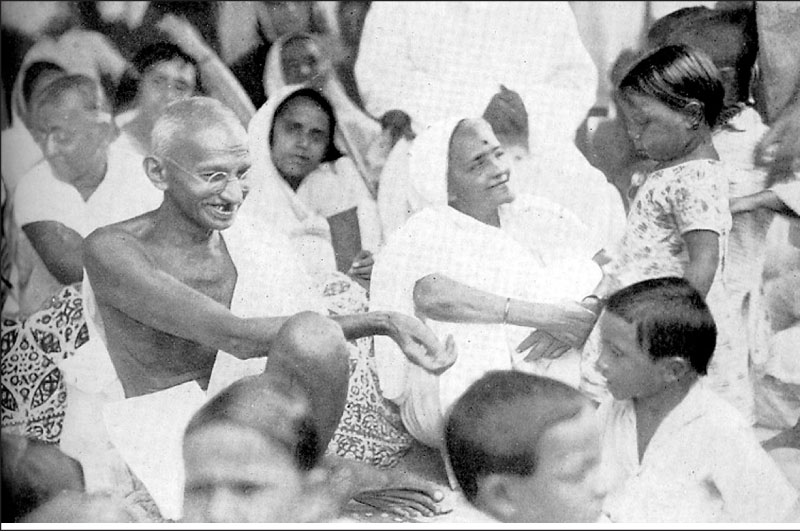Friday Apr 18, 2025
Friday Apr 18, 2025
Monday, 9 May 2022 00:37 - - {{hitsCtrl.values.hits}}

Gandhi as a servant leader among the people
 The presence and absence of leadership in various circles is very much evident in the current chaos we are experiencing. The illusive and repulsive ways of clinging onto power by so called leaders have demonstrated the absence of leadership essentials in them. Today’s column is yet another reflection on servant leaders, with emphasis on the current Sri Lankan context.
The presence and absence of leadership in various circles is very much evident in the current chaos we are experiencing. The illusive and repulsive ways of clinging onto power by so called leaders have demonstrated the absence of leadership essentials in them. Today’s column is yet another reflection on servant leaders, with emphasis on the current Sri Lankan context.
Overview
We have got used to worshipping heroes. When heroes become zeros because of their own ill doings, we find yet another set of heroes. The former heroes who left as zeros are now coming back in new clothes to appear as a new set of heroes. This has been the vicious cycle since regaining of independence in 1948. It highlights the acute absence of servant leadership with associated authentic and transparent systems.
Leadership is not about positions and titles, but about decisions and actions. It is essentially a mindset. We look at the leaders at the top but not the “leaders at the tap.” Servant leadership is one solid way of looking at the dynamics of leadership. It is perhaps, one of the most ancient forms of leadership, aptly found in all great religious founders. When you consider the Five Hundred and Fifty Jataka Stories, more than 50% of the time, Bodhisathva is portrayed as a leader. In some cases, as a one who serve others. In brief, a servant leader is a servant first. The simple motto is service first.
Chanakya, the famous author of Arthashastra: wrote, in the 4th century B.C as follows:
“The king (leader) shall consider as good, not what pleases himself but what pleases his subjects (followers)”... “The king (leader) is a paid servant and enjoys the resources of the state together with the people.”
There are passages that highlight the servant dimension of leadership, attributed to Lao-Tzu, who is believed to have lived in China sometime between 570 B.C. and 490 B.C.
“The highest type of ruler is one of whose existence the people are barely aware. Next comes one whom they love and praise. Next comes one whom they fear. Next comes one whom they despise and defy. When you are lacking in faith, others will be unfaithful to you. The Sage is self-effacing and scanty of words. When his task is accomplished and things have been completed, all the people say, ‘We ourselves have achieved it!’.”
The fascinating point here is that the servant leader appears as a “leader breeder” in developing his/her followers to serve others.
Branding of servant leadership
As in the case of several management concepts, the west “branded” the servant leadership. Robert Greenleaf, a scholar from USA gets the credit for documenting the features and facets of servant leaders. Having worked for AT&T for several decades, he realised the limitations of typical administrative leaders. Having contemplated an alternative, the resulting model was the repackaged concept of servant leadership.
Let us look at how he describes the concept further:
“The servant-leader is servant first. Becoming a servant-leader begins with the natural feeling that one wants to serve, to serve first. Then conscious choice brings one to aspire to lead. That person is sharply different from one who is leader first. The difference manifests itself in the care taken by the servant first to make sure that other people’s highest priority needs are being served. The best test, and the most difficult to administer, is this: Do those served grow as persons? Do they, while being served, become healthier, wiser, freer, more autonomous, more likely themselves to become servants?”
Servant-leaders achieve results for their organisations by giving priority attention to the needs of their colleagues and those they serve. Servant-leaders are often seen as humble stewards of their organisation’s physical, financial, and most importantly, human resources.
Qualities of servant leaders
“Servant leadership is a blend and balance between leader and servant,” says Skip Prichard, who runs a centre on Servant Leadership. You do not lose leadership qualities when becoming a servant leader. According to him, following are the qualities of a servant leader:
Values diverse opinions
Cultivates a culture of trust
Develops other leaders
Helps people with life issues
Encourages
Sells instead of tells
Thinks you, not me
Thinks long-term
Acts with humility
There is no doubt that the above list is relevant to Sri Lankan business leaders. Special emphasis should be made on the final one. It reaffirms what Jim Collins, in his seminal book, Good to Great, mentioned about great leaders who have professional will and personal humility. Servant leaders do not get on to other’s shoulders but might carry others on their shoulders.
Characteristics of servant leaders
There are many characteristics can be found in a servant leader. Larry C. Spears, who has served as President and CEO of the Robert K. Greenleaf Center for Servant Leadership since 1990, has extracted several characteristics that are central to the development of a servant leader.
You cannot serve others without properly listening to them. A servant leader has the motivation to listen actively to his team and supports them in decision identification. This applies particularly to pay attention to unspoken. This means relying on his/her inner voice and find out what the body, mind and spirit are communicating.
Mahatma Gandhi did that with fellow Indians. Managers need to do that with their teams. CEOs need to do that with their employees. In essence, servant leaders listen with care. As we discussed last week, Sri Lankan business leaders can improve their current level of listening to a much higher level.
A servant leader attempts to understand and empathise with others. Workers may be considered not only as employees, but also as people who need respect and appreciation for their personal development. Japanese business leaders have demonstrated this characteristic a lot in their typical approach to work. Here, leadership is seen as a special type of human work, which ultimately generates a competitive advantage. A great strength of a servant leader is the ability for healing oneself and others. A servant leader tries to help people solving their problems and conflicts in relationships, because he/she wants to develop the capabilities of each individual. This leads to the formation of a business culture, in which the working environment is characterised by dynamic, fun and no fear from failure.
Mother Theresa did this with destitute street children. HR professionals can demonstrate this in their coaching and counselling activities. Every manager can be a healer in such a manner that he/she strengthens inter-personal relationships.
A servant leader does not take advantage of his power and his status by forcing others to comply. He/she rather tries to convince them. This element distinguishes servant leadership most clearly from traditional, authoritarian models and can be traced back to the religious views of the inventor Robert Greenleaf. This is one area where Sri Lankan managers can learn. Instead of forcing people to do things, convincing them of the benefits of doing particular things is what is needed.
Servant leadership is seen as an obligation to help and serve others. Openness and persuasion are more important than control. It reminds me what Prime Minister S.W.R.D. Bandaranaike told the nation. The prime obligation of the man is to serve the humankind. This offers fresh insights about our traditional leadership hierarchy. Instead of looking up to see how your boss is doing, you should look in front to see whether your customers are delighted or not.
Ahimsa as a leadership response
What we see in Sri Lanka with peaceful and non-violent demonstrations against the present regime highlights the true potential of ahimsa. It essentially highlights the spiritual power of non-violence. Mahatma Gandhi observed it as follows: “Nonviolence is an active force of the highest order. It is soul force or the power of Godhead within us. Imperfect man cannot grasp the whole of that essence – he would not be able to bear its full blaze, but even an infinitesimal fraction of it, when it becomes active within us, can work wonders.”
He further illustrates the potent power of ahimsa. “My nonviolence is made of stern stuff. It is firmer than the firmest metal known to the scientists. Nonviolence, in its dynamic condition means conscious suffering. If nonviolence is to be contagious and infectious, I must acquire greater control over my thoughts. A nonviolent action accompanied by nonviolence in thought and word should never produce enduring violent reaction upon the opponent. A nonviolent warrior knows no leaving the battle. He rushes into the mouth of himsa, never even once harbouring an evil thought. His nonviolence demands universal love, and we are not a small part of it.
The current social actions by committed youth with many innovative aspects demonstrates the features of servant leadership. Of course, the way the attempts being made to suppress it by violent means shows the absence of servant leadership where it should really be present. That is the plight that we Sri Lankans currently observing with multiple uncertainties.
Way forward
Servant leadership is high in demand in many fronts of Sri Lanka. Being empathic towards the suffering Sri Lankans and making sacrifices to address their dire needs is something so elementary that we expect from the elected leaders of the nation. Instead, if they are still focusing on how to be served, with an opportunistic agenda, only a disaster can be expected. The fatigued Mother Lanka is eagerly waiting to see sensible servant leaders at the helm. In essence, those who serve deserve leadership.
(The writer is the immediate past Director of the Postgraduate Institute of Management, and can be reached through [email protected], [email protected] or www.ajanthadharmasiri.info.)